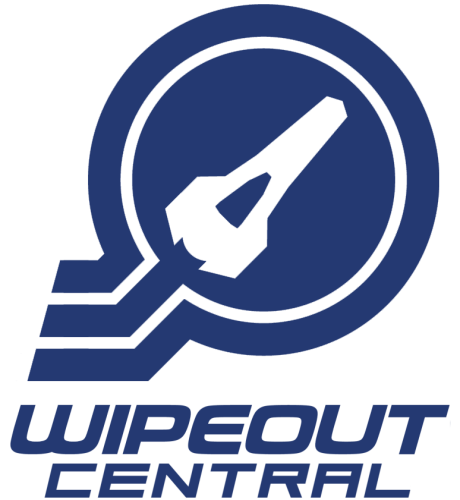Wipeout 2097 (or Wipeout XL in the USA; styled wipE'out" 2097) is a 1996 racing video game. It is the second game released in the Wipeout series by developers Psygnosis, and a year after the original game in the series.
Wipeout 2097 is set over four decades after the original Wipeout and introduces the player to the much faster, more competitive, and more dangerous F5000 AG Racing League. The game is set just over 101 years after the actual release year of the game on the original PlayStation console.
Gameplay[]

Official logo of the F5000 Anti-Gravity Racing League
Gameplay did not differ much from the previous title. Aside from the different circuits and new weapons, the fundamental aspects were kept. Pilots would race each other or computer controlled A.I. opponents, in order to finish in the highest position possible. In order to help them achieve this end, weapons were provided.
Though the crafts are capable of very high straight line speeds, their steering often needs to be assisted by a secondary system to generate the extra turning force needed to navigate tight corners effectively. This secondary system is the craft's Air Brakes. Just moving a craft left or right alone is very responsive, but by using an airbrake of the direction to turn in, players can perform very tight turns at near top speed, including those greater than 90 degrees. When an airbrake is applied, the change in direction it causes starts relatively small, but as it continues it significantly increases the change in direction. Where necessary, the player may also use both air-brakes for rapid deceleration - typically used if the pilot has flown off the racing line in tight corners and needs to steady their craft. Due to the unfamiliarity of controls and relentless succession of tight turns at high speeds, many players took a long time to get used to handling of the ships, but for those that persevered, it offered great rewards.
Aside from the usual tactical aspects of racing, Wipeout 2097, unlike its predecessor, allowed players to not only stall, but also damage and eliminate opponents through the use of weapons. Each craft has a shield energy pool, and when this pool is depleted—either from damage sustained from weapon attacks, or impact damage, the craft would be destroyed. The craft would also blow up if you did not race fast enough, though this only applied to human players. The only way to restore shield energy is to fly through a pitlane, which can often be seen designated onto one side of the track. The biggest weapon introduced in Wipeout 2097 was the Quake Disruptor, which has been a series hall mark ever since. This weapon causes a quake to thrust a destructive wave down the track that damages the ships it smashes into.
The aim of the game was simple: to complete various and increasingly difficult challenges in order to move onto the next one. Changing the difficulty level was simply that of upping the top speed of the craft, through four different speed classes (Vector, Venom, Rapier, Phantom). The number of laps needed to complete a race also increased with each new class.
Victory in the challenge modes were the game's ultimate accomplishment. These modes are similar to a Championship where players have to race every track to become champion. However, rather than tallying up points, Challenge mode took a very single player centric approach by only allowing progress to the next track by winning the current track (not coming first meant it had to be repeated). Players could lose the challenge by losing all 3 lives, which are lost by finishing lower than 3rd place. By winning all races, the player is crowned champion and given access to first Phantom class, then the Piranha prototype craft.
Development[]
Wipeout 2097 moved the franchise forward, introducing vastly improved graphics over the original, many more tracks and more innovative track designs, and new teams and craft. The game also featured the new ability to actually damage your opponent's racing craft instead of merely stalling them as in the original game, and even potentially blowing them up and therefore removing them from the race and lessening the number of opponents. The player can also take on damage from enemy fire and be blown up, but the ship can be "recharged" to health at the pitstop in exchange for a precious few seconds of the race. Added to this new tactical combat element is an array of new weapons in addition to the ones established in the first game, such as the Quake Disruptor (which sent a ripple down the track) that became instant fan favourites. To cater for the increase in Wipeout players, an easier learning curve was introduced whilst keeping the difficulty at top end for the experienced gamers.
The Designers Republic returned to work on the visual style and artwork, as they did in the previous game. Music artists contributing to the in-game soundtrack included The Prodigy, The Future Sound of London, The Chemical Brothers, Fluke, and Underworld. There was also a popular soundtrack album. An entire nightclub tour was also initiated in conjunction with Red Bull Energy Drink, which was featured prominently throughout the game, before the drink actually gained popularity in the American market.
Tracks[]
- Talon's Reach
- Sagarmatha
- Valparaiso
- Phenitia Park
- Gare d'Europa
- Odessa Keys
- Vostok Island
- Spilskinanke
Teams[]
Weapons[]
Music[]
The soundtracks of the PlayStation, Sega Saturn and Windows versions may also be played by inserting the CD into a CD player (and skipping the first track). Some of these soundtracks were later released as a music-only CD, though with a different track listing.
PlayStation[]
- The Future Sound of London - "We Have Explosive"
- The Future Sound of London - "Landmass"
- Fluke - "Atom Bomb (Straight 6 Instrumental Mix)"
- Fluke - "V Six"
- The Chemical Brothers - "Dust up Beats"
- The Chemical Brothers - "Loops of Fury"
- Photek - "The Third Sequence"
- Underworld - "Tin There (Underworld Edit)"
- The Prodigy - "Firestarter (Instrumental)"
- CoLD SToRAGE - "Canada"
- CoLD SToRAGE - "Body in Motion"
Saturn/Windows[]
- CoLD SToRAGE - "Canada"
- CoLD SToRAGE - "Body in Motion"
- CoLD SToRAGE - "Kingkong"
- CoLD SToRAGE - "Plasticity"
- CoLD SToRAGE - "Messij Xtnd"
- CoLD SToRAGE - "Tentation"
- CoLD SToRAGE - "Surgeon"
- CoLD SToRAGE - "Hakapik Murder"
- CoLD SToRAGE - "Messij Received"
- CoLD SToRAGE - "Body Plus" (Saturn exclusive)
Reception[]
The lack of a split screen two player option on the PlayStation version was seen as a serious flaw by many players. Mirroring the trend of many PlayStation games early in the console's life, Wipeout 2097 offered only a console link-up section requiring players to have access to a link cable, two television sets, two PlayStation consoles, and two copies of the game, which was very rare.
In spite of this, the single player received considerable praise for its technically challenging racing and fusion of popular culture elements. Many sources cite the unique blend of techno music and designer logos in one cohesive futuristic racing universe as the beginning of a new trend in gaming to tap into popular culture and other arts, which was made possible by the new storage space of the time. In IGN's top 25 PSX games of all time list it ranked 13th, citing that it was often considered the PlayStation's best racing game of its time and was chosen ahead of others in the series because its the one they prefer to keep coming back to. Currently it also ranks as the forth best PSX game at Gamerankings with an average review score of 94.61 from 9 different sources.
Reviews[]
- Official PlayStation Magazine (Australia): 10 out of 10 (100%)
- Official UK PlayStation Magazine: 9 out of 10 (90%)
- IGN: 9.0 out of 10 (90%) (PlayStation version reviewed)
- GameSpot: 8.5 out of 10 (85%) (PlayStation version reviewed)
- GameSpot: 7.1 out of 10 (71%) (PC version reviewed)
- Edge (magazine): 8 out of 10 (80%) (PlayStation version reviewed)
Trivia[]
- The game was originally teased under the working name of Wipeout II as seen when the player completes the previous game on Rapier class.
- The original title in the US version was originally going to be Wipeout XS (Excess), but was changed to XL (extra large) due to fears that "XS" would mean extra small.
- The intro movie features a shortened cut of the song "Herd Killing" by the Future Sound of London.
- This is the only game in the series where tracks have elemental features, such as lightning flashes on stormy circuits (the most notable being Gare d'Europa).
- This is the first game to feature the use of dual-hulled ships such as that of the Auricom F5000 and Qirex F5000 (including hybrid designs like the AG Systems F5000), however, the Auricom Prototype in the AGRC was the first dual-hulled ship in the history of Anti-Gravity Racing.
- Despite this game being the first to introduce the elimination mechanic, craft-destroying weaponry was present during the AGRC days, as well as the ability to eliminate ships, just before regulations were heavily revised during the F3600.
- Another is despite this game marking Piranha's first appearance in the series, they have originally raced in the AGRC under the name of Pir-hana, only to withdraw from anti-gravity motorsport shortly after the 2050 season, which meant that they reappeared after a long absence.
- This is the first game in the series where the teams' liveries on their respective ships had unique colors associated with their brand identity. In the series storyline, however, this went as far back as the team liveries used in the AGRC.
- This would be the last title in the series to be made as a multi-platform title outside of PlayStation.
- The Qirex ship on the cover erroneously uses Piranha livery colors.
- This is the only game in the series to show an "aerodynamics" stat for the ships, which determines the overall stability of the ships when turning.
- The intro movie shows the in-game HUD inside the windshield of the Qirex ship.
- This is the first game in the series to use special cheats, such as the ability to have an unlimited variety of weapons without needing to fly over weapon pads and even a cheat that spawns a machine gun (at the expense of using any other weapons, and will slow the ship down upon firing).
- Despite the Piranha P.666 v.Prototype lacking any weaponry, the machine gun cheat can be used with it.
- One of the unique special cheats must be activated before the start of the game, which will turn the ships into unique "animal" ships that give them a more cartoony appearance, with FEISAR as a bee, AG Systems as a snail, Auricom as a UFO, Qirex as a pig and Piranha as a shark.
- The music video of one of the songs featured in the game, "Atom Bomb" by Fluke, uses footage from this game.
- Despite the significantly larger number of weapons available, AI opponents never use the Quake, Plasma and Thunder Bomb.
| All Wipeout Games |
|---|
| 1990s: WipEout • 2097/XL • 64 • Wip3out |
| PS2/PSP: Fusion • Pure • Pulse |
| PS3/Vita: HD (Fury) • 2048 |
| PS4: Omega Collection |
| Mobile: Merge |
